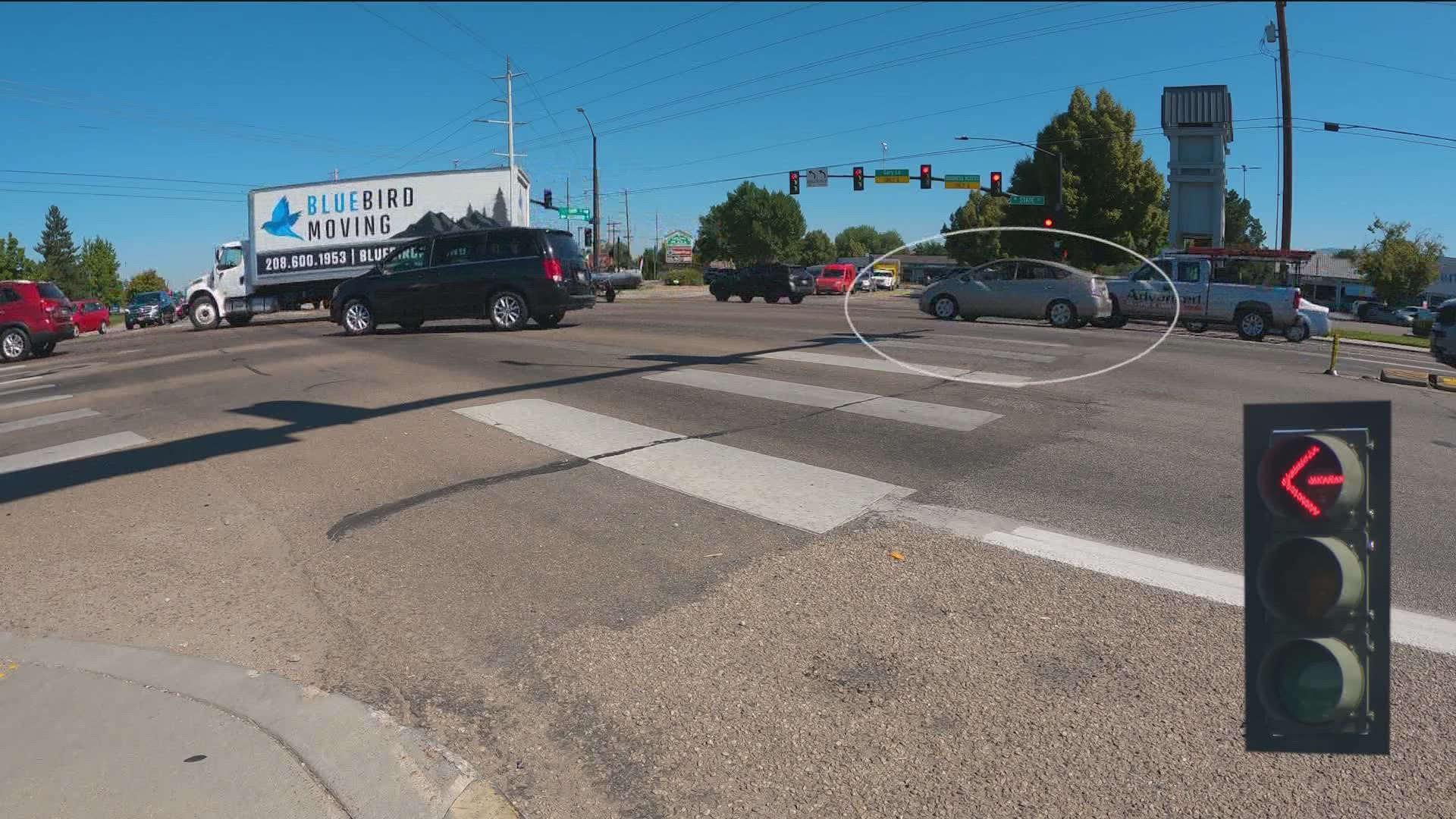BOISE, Idaho — There is a certain intersection in town where drivers seem to disregard the left turn red light, a lot.
State Street is one of the Treasure Valley's major streets for getting around. Tens of thousands of cars use this corridor on a daily basis and depending on the day, it may seem like other drivers are driving in the same direction, at the same time, as you.
The Ada County Highway District (ACHD) said the Glenwood State Street intersection sees around 20 thousand cars a day.
"Once the vehicle passes the stop line after the light turns red, that's an obvious violation," Sgt. Matt Konvalinka with the Boise Police Department said. "You get those heavy traffic times, it's not uncommon to see it at all of our intersections."
Sgt Konvalinka said complaints about speeding, aggressive driving, and running red lights are common. He has heard complaints specifically about the Glenwood/State Street intersection.
But what about during lighter traffic times, when it is supposed to be off-peak hours? On a Friday morning between 10 and 11, there were still a lot of left-turn, red light runners.
"It's yellow, people are still entering, and once it turns red, see that's kind of borderline," Konvalinka said. "Now the yellow is supposed to give you enough time to slow down and stop, but if you don't and you roll past the stop line on a red light, that's a failure to obey a traffic control device."
A violation that was observed a lot. So why do cops not just camp out and write a bunch of tickets?
"I've gotta see that light turn red. The time between that light turning red and I look down to the stop line to see the vehicle past the stop line," Konvalinka said. "I have to testify to that in court."
But is this a timing thing or is this a driver issue? Sgt. Konvalinka said it is both.
"Granted you shouldn't be entering the intersection or passing that stop line once the light is red, you shouldn't be entering that intersection," Konvalinka said. "But in order to prevent accidents, I'd like to see the timing extended to give everyone a chance to clear the intersection before the other side turns green."
The timing is controlled by ACHD, where they see red light runners as they happen on their 205 closed circuit cameras.
"We've noticed there are a few more red light runners throughout Ada county." Mike Boydstun, the Congestion Management Supervisor with ACHD for the last 21 years. "Over the past I'll say 2-3 years is that a lot of drivers have become a lot less patient."
Boydstun said the State and Glenwood intersection has 5-6 different timing cycles based on the time of day. How long lights are green or red is affected by an algorithm, a formula formed by one week's worth of traffic.
A cycle could take anywhere from two minutes to two minutes and forty seconds. The more cars needing to go in one direction, the longer the light is green.
"That westbound left turn gets 15 to 30 seconds of green time out of that cycle," said Boydstun.
We counted about 20 seconds, from going green, and then back to red, with about four seconds of yellow in between.
"We also put what we call an all red interval in there, so it's red for all movements at the intersection before the next conflicting green would be displayed," Boydstun said.
Boydstun said the solution may be as simple as adjusting that red light interval, giving cars time to clear the intersection.
"It might be something where adding a half second could make everything a little bit safer, that might steal a little green time from everyone but it might make it safer," Boydstun said.
Sgt. konvalinka agrees, it might be easier to stall the starts than stop the runners.
"People will still run the red light but at least it will prevent an accident which is what we really want to do, we want to stop the accidents," Konvalinka said.
So the ultimate goal is to prevent accidents and keep streets safe.
Boise police told us so far this year, well, half of this year, from January to June, they issued 60 red light citations.
Not at this intersection, but across the city.
Also at this intersection, over the same period of time, BPD responded to 135 traffic-related issues, 26 of them crashes, making State and Glenwood 8th on the list of intersections with the most crashes this year.
So, what about the solution?
Maybe you drive through that intersection during that same time of day we described and maybe you noticed those same issues we did two weeks ago, but you're not noticing them now.
That's because the day after we spoke with them, ACHD adjusted the timing of that cycle, increasing it from 120 seconds to 130 seconds.
And they added a half second to that red light interval, when all the lights are red in every direction to allow cars to clear the intersection.
And maybe you're thinking, 'well, they fixed the problem, why run the story?'
Because, like we learned in our discussion with ACHD, sometimes to solve a problem, all you have to do is bring it to someone's attention.
ACHD said they encourage anyone who sees a traffic problem to report it to them and they will do what they can to fix it.
Join 'The 208' conversation:
- Text us at (208) 321-5614
- E-mail us at the208@ktvb.com
- Join our The 208 Facebook group: https://www.facebook.com/groups/the208KTVB/
- Follow us on Twitter: @the208KTVB or tweet #the208 and #SoIdaho
- Follow us on Instagram: @the208KTVB
- Bookmark our landing page: /the-208
- Still reading this list? We're on YouTube, too:

